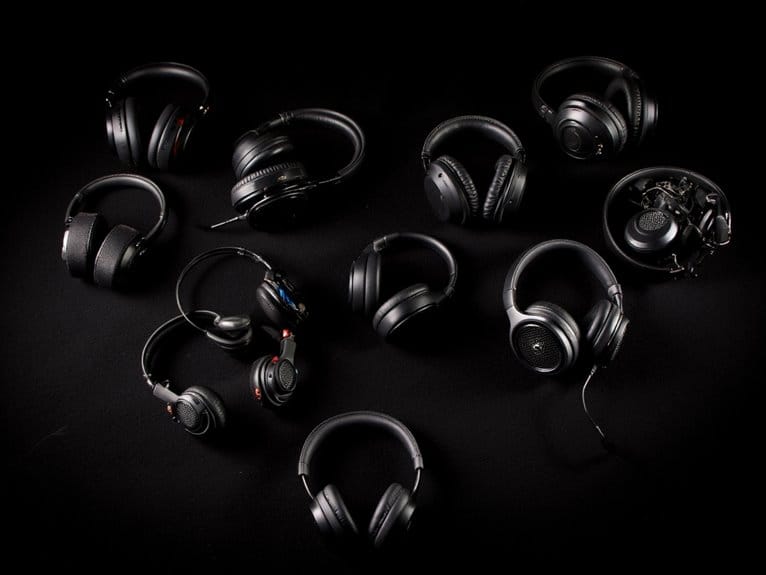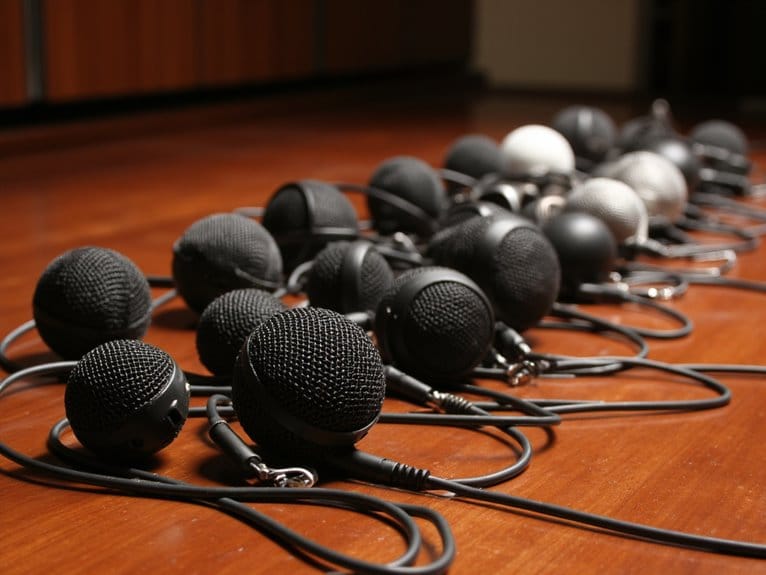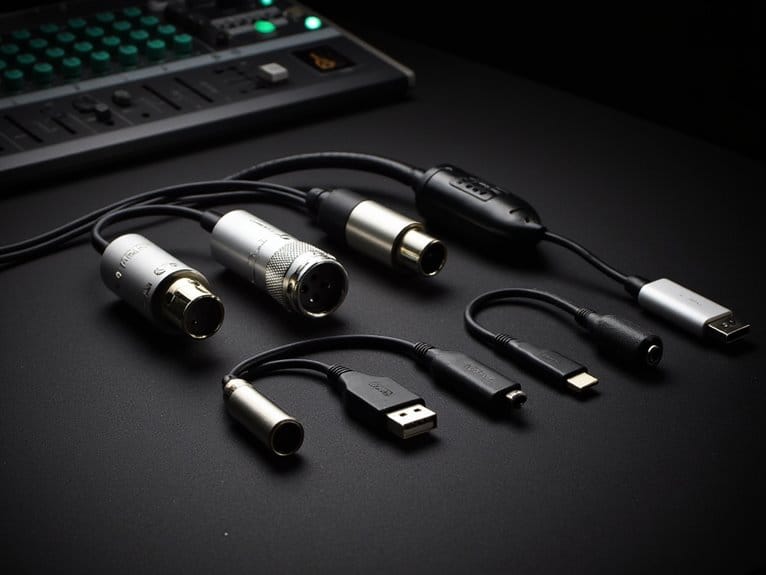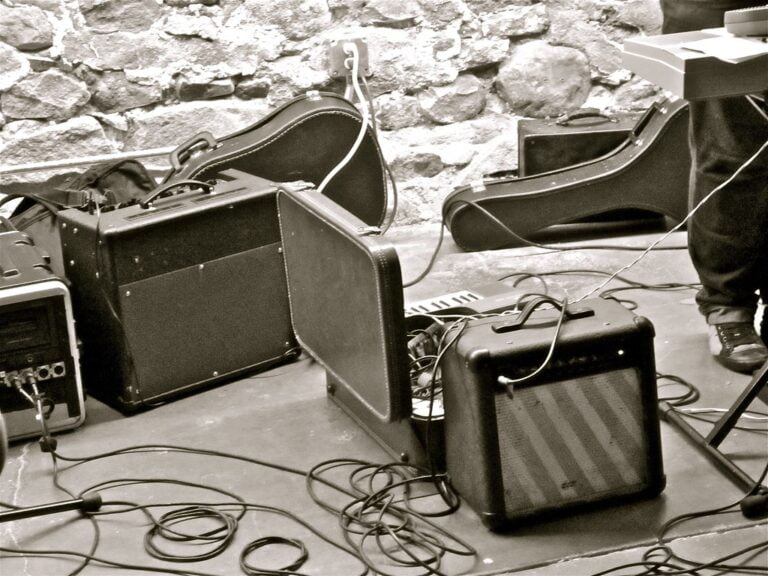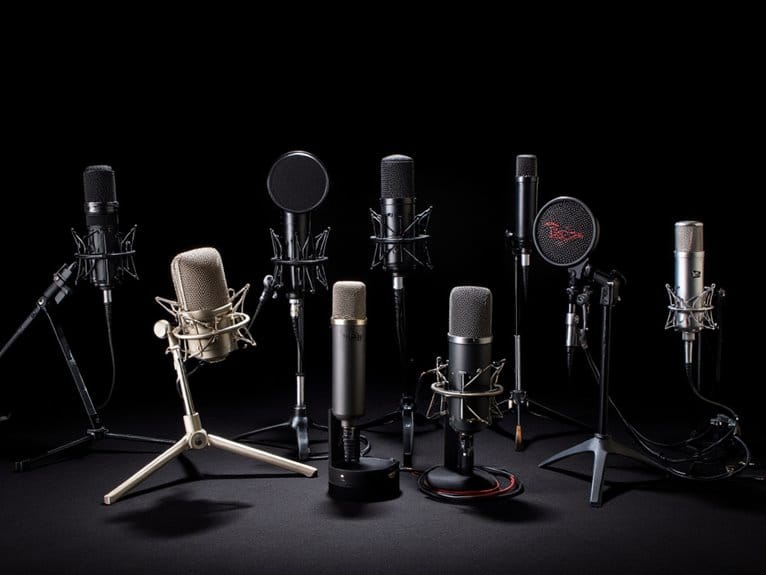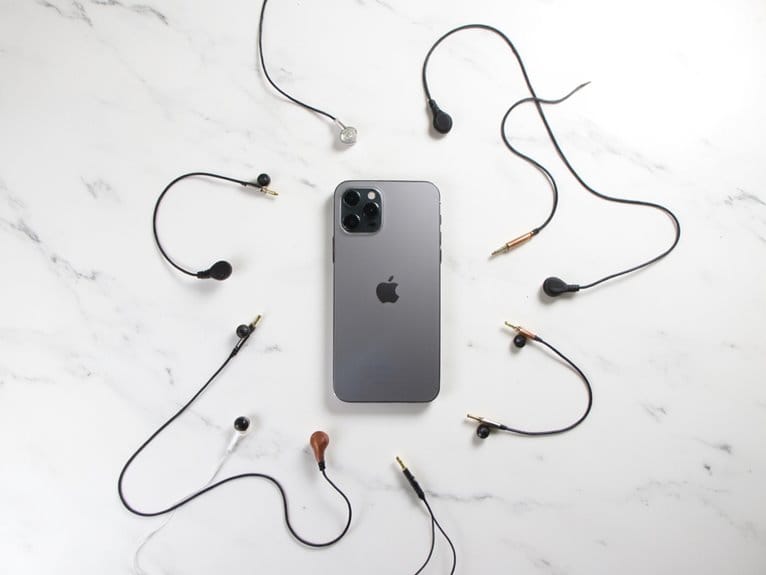10 Best Field Recorders for Professional Audio Recording
After testing dozens of field recorders this year, I’ve found the 2025 lineup excels with 32-bit float technology that eliminates clipping during unexpected volume spikes. The TASCAM DR-40X leads with 4-track capabilities and dual XLR inputs, while Zoom’s H4essential offers distortion prevention up to 130 dB SPL. Budget-conscious users should consider the DR-05X for its 17.5-hour battery life, though complex menu systems challenge beginners across most models. Continue below to discover which specific features match your recording needs.
We are supported by our audience. When you purchase through links on our site, we may earn an affiliate commission, at no extra cost for you. Learn more.
Notable Insights
- Professional field recorders feature 32-bit float recording technology to eliminate clipping and capture extreme dynamic ranges.
- Top models include TASCAM Portacapture X8, Zoom H4essential, and DR-40X offering multi-channel recording capabilities.
- Key specifications to evaluate include bit depth, sample rates, phantom power support, and XLR/TRS input options.
- Battery performance varies significantly, with DR-05X offering 17.5 hours while Zoom F3 provides six hours runtime.
- Price ranges widely but customer ratings consistently fall between 4.2-4.7 stars across professional-grade field recording devices.
TASCAM DR-40X 4-Track Portable Handheld Field Recorder

The TASCAM DR-40X stands as a versatile workhorse for content creators, musicians, and audio professionals who need reliable 4-track recording capabilities without breaking the bank. You’ll appreciate the high-quality unidirectional stereo condenser microphones that record in both A-B and X-Y positions, giving you flexibility for various recording environments, while the dual XLR/TRS inputs handle +4dBu line levels and provide +48V phantom power for professional microphones. The 4-channel mode enables dual recording and nondestructive overdub functionality, and it doubles as a USB audio interface for your computer or iOS device, recording up to 24-bit resolution.
Best For: Content creators, musicians, podcasters, and audio professionals who need a portable, reliable 4-track recorder with professional XLR inputs and USB audio interface functionality at an affordable price point.
Pros:
- High-quality built-in condenser microphones with flexible A-B and X-Y positioning options for various recording scenarios
- Professional connectivity with dual XLR/TRS inputs supporting +48V phantom power and +4dBu line levels
- Versatile 4-channel recording mode with nondestructive overdub capabilities and USB audio interface functionality
Cons:
- Manual lacks comprehensive details, requiring users to reference additional documentation on manufacturer’s website
- Requires practice and learning curve to fully utilize all available features effectively
- Does not include USB cable for computer connection despite advertising USB interface capability
Tascam DR-05X Stereo Handheld Digital Audio Recorder

Budget-conscious professionals and hobbyists will find the Tascam DR-05X delivers impressive recording capabilities without breaking the bank, though I’ll admit its compact size might fool you into underestimating its potential. You’ll appreciate the dual internal condenser microphones, which capture everything from whispered dialogue to concert performances with surprising detail and clarity. The revamped interface streamlines your workflow, letting you record, adjust levels, delete takes, and add markers without fumbling through complex menus. With 17.5 hours of battery life on two AA batteries, you won’t find yourself scrambling for power during extended sessions, and the USB audio interface mode transforms it into a capable podcasting companion.
Best For: Budget-conscious professionals and hobbyists who need a reliable portable recorder for field recording, podcasting, voiceovers, and music projects without sacrificing audio quality.
Pros:
- Dual internal condenser microphones capture detailed audio from quiet dialogue to loud performances
- Exceptional 17.5-hour battery life on AA batteries eliminates power concerns during extended recording sessions
- USB audio interface mode enables direct connection to PCs for podcasting, streaming, and studio work
Cons:
- Compact size may be misleading about capabilities and could feel less substantial than larger recorders
- Limited to stereo recording with only internal microphones, restricting advanced multi-input scenarios
- Basic handheld design may lack advanced features found in higher-end professional recording equipment
Zoom H1essential Stereo Handy Recorder with 32-Bit Float
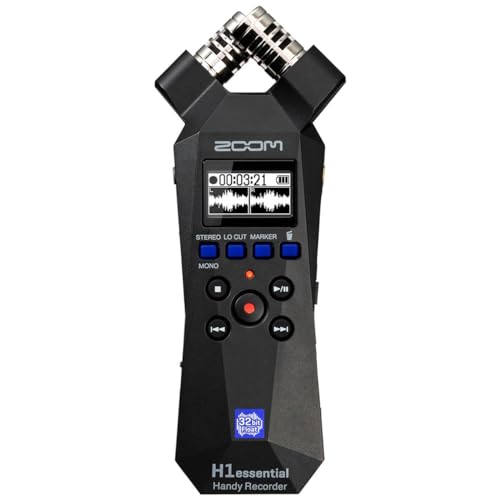
Content creators working in unpredictable audio environments will find the Zoom H1essential Stereo Handy Recorder’s 32-bit float recording capability removes the guesswork that typically plagues field recording sessions. You’ll capture clean audio up to 120 dB SPL through its X/Y microphones, while the 96kHz sample rate guarantees professional-quality recordings on any micro SD card. At 3.25 ounces, this recorder doubles as a USB microphone for your computer or mobile device, though you’ll need to budget for AAA batteries and storage separately. The audio guidance feature makes it accessible for visually impaired users, and frankly, the voice prompts help everyone navigate those admittedly tiny buttons more efficiently.
Best For: Content creators, musicians, podcasters, and filmmakers who need professional-quality portable recording in unpredictable environments, especially those who want to eliminate gain-setting challenges with 32-bit float technology.
Pros:
- 32-bit float recording eliminates the need for gain adjustment and prevents clipping in dynamic audio environments
- Compact and lightweight design (3.25 oz) with dual functionality as both standalone recorder and USB microphone
- Audio guidance feature makes it accessible for visually impaired users while helping all users navigate the interface
Cons:
- Small buttons can be difficult to operate for users with larger hands
- Requires separate purchase of AAA batteries and micro SD card, adding to the total cost
- Lightweight construction may feel less durable compared to higher-end recording equipment
Zoom F3 2-input Field Recorder (F3Zoomd1)

Professional audio engineers and content creators who need foolproof recording without constant level monitoring will find the Zoom F3’s 32-bit float technology a game-changer for their workflow. This compact two-channel recorder, measuring just 3 x 3.5 x 2 inches and weighing one pound, eliminates clipping entirely while delivering professional-grade audio through dual XLR inputs with phantom power support. You’ll appreciate the six-hour battery life from two AA batteries, though you’ll need external mics since none are built-in. The rugged metal-plastic construction handles field conditions well, and with 374 users rating sound quality at 4.7 stars, it’s clearly delivering on its promises for portable recording applications.
Best For: Professional audio engineers, content creators, and field recording enthusiasts who need reliable, high-quality audio capture without the hassle of constant level monitoring.
Pros:
- 32-bit float recording technology completely eliminates clipping and removes the need for level monitoring during recording
- Compact, lightweight design (1 pound, 3×3.5×2 inches) with excellent 6+ hour battery life makes it ideal for portable field recording
- Professional-grade audio quality with dual XLR inputs, phantom power support, and very low self-noise at a competitive price point
Cons:
- No built-in microphones included, requiring separate mic purchases for complete setup
- Lacks 3.5mm input options, limiting connectivity to XLR sources only
- Missing file name display during recording and some menu navigation limitations
Zoom H4essential 4-Track Handy Recorder with 32-Bit Float

Musicians and podcasters who’ve wrestled with clipped audio during unexpected loud moments will find their salvation in the Zoom H4essential’s revolutionary 32-bit float recording technology, which eliminates the need to set gain levels and prevents distortion even when capturing sounds up to 130 dB SPL. At 8.6 ounces, this four-track recorder packs serious punch with X/Y microphones, two XLR/TRS combo inputs featuring ultra-clean Zoom preamps, and the ability to record simultaneously to SD card and USB interface. I’ve found the accessibility features particularly impressive, including audio guidance for visually impaired users, though I’d appreciate announced file names for better workflow management.
Best For: Musicians, podcasters, and audio professionals who need a portable, high-quality recorder that eliminates distortion concerns through 32-bit float technology while offering accessibility features for visually impaired users.
Pros:
- 32-bit float recording eliminates the need to set gain levels and prevents clipping distortion up to 130 dB SPL
- Dual recording capability to SD card and USB interface simultaneously with support for cards up to 1TB
- Excellent accessibility features including audio guidance function and tactile buttons for visually impaired users
Cons:
- Does not support overdubbing (recording while playing back existing tracks)
- Accessibility features could be improved with announced file names and track status indicators
- Battery life varies significantly depending on battery type used
Zoom PodTrak P4 Podcast Recorder with 4 Microphone Inputs

Four microphone inputs, four headphone outputs, and user-recordable sound pads make the Zoom PodTrak P4 an ideal choice for podcasters who need to record multiple participants simultaneously without breaking the bank. You’ll appreciate the intuitive controls, phantom power support for condenser mics, and mix-minus functionality that enables seamless phone interviews without feedback. Recording to SD cards while simultaneously streaming to computers or phones provides excellent workflow flexibility. At 4.6 ounces with impressive battery life from two AA batteries, it’s remarkably portable despite lacking professional line outputs and 32-bit recording capabilities found in pricier alternatives.
Best For: Podcasters and content creators who need to record multiple participants simultaneously on a budget while maintaining good audio quality and portability.
Pros:
- Intuitive, user-friendly design with simple controls that require no manual reading
- Excellent portability at 4.6 ounces with long battery life from two AA batteries
- Mix-minus functionality enables seamless phone interviews without feedback issues
Cons:
- Lacks professional line outputs, which may introduce noise when using headphone outputs
- Limited to 16-bit/44.1 kHz recording format that may not meet professional standards
- Compact controls can be challenging for users needing extensive simultaneous functions
TASCAM Portacapture X8 32-bit 8-Channel Multitrack Field Recorder

The TASCAM Portacapture X8 emerges as a compelling choice for content creators who need multiple simultaneous inputs without breaking the bank, delivering eight channels of recording capability in a surprisingly compact 9 x 7 x 3-inch package that weighs just 1.61 pounds. You’ll appreciate the 32-bit float recording at up to 192kHz, which practically eliminates clipping concerns while the four XLR/TRS combo jacks with individual phantom power handle professional microphones effortlessly. The 3.5-inch color touchscreen proves remarkably responsive, and I’ve found the Bluetooth remote control genuinely useful during complex recording sessions, though you’ll want external mics since the onboard condensers feel somewhat fragile for serious field work.
Best For: Content creators, podcasters, musicians, and field recording enthusiasts who need professional-quality multi-channel recording capabilities at an affordable price point.
Pros:
- 32-bit float recording at up to 192kHz virtually eliminates clipping issues while delivering exceptional audio quality
- Compact and lightweight design (1.61 lbs) with intuitive 3.5-inch color touchscreen and useful Bluetooth remote control
- Four XLR/TRS combo jacks with individual phantom power and HDDA mic preamps provide professional connectivity options
Cons:
- Onboard condenser microphones are fragile and made of plastic, requiring external mics for serious field work
- Limited onboard speaker functionality may require headphones for proper monitoring
- Reduced to 24-bit/96kHz recording mode needed to manage storage usage for longer sessions
TASCAM 4-Channel Portable Audio Recorder (DR-60DmkII)

Compact DSLR videographers and content creators who need professional-quality audio recording without the bulk will find the TASCAM DR-60DmkII to be a compelling solution, weighing just 1.12 pounds while delivering four simultaneous recording channels. You’ll appreciate the upgraded HDDA preamps that provide up to 64dB of gain with remarkably low noise levels, though I’ll admit the roughly four-hour battery life with phantom power can be frustrating during longer shoots. The dual XLR/TRS combo inputs with 48V phantom power handle professional microphones beautifully, while the additional 3.5mm inputs accommodate wireless and lavalier mics for versatile recording setups that capture pristine 96kHz/24-bit WAV files. The TASCAM DR-60DmkII pairs exceptionally well with some of the best microphones for streaming audio, making it a top choice not only for videographers but also for podcasters and live streamers. Its rugged construction and intuitive interface ensure that even first-time users can achieve high-quality recordings without the steep learning curve. With its comprehensive features, this recorder truly stands out as an invaluable tool for enhancing any audio project.
Best For: Content creators and DSLR videographers who need professional 4-channel audio recording in a compact, lightweight package for film production and field recording applications.
Pros:
- Upgraded HDDA preamps deliver up to 64dB of gain with exceptionally low noise levels for professional audio quality
- Records up to 4 channels simultaneously at 96kHz/24-bit resolution with safety track feature to prevent overload
- Versatile input options including XLR/TRS combo connectors with 48V phantom power and dual 3.5mm inputs for wireless mics
Cons:
- Short battery life of approximately 4 hours when using phantom power, requiring frequent battery changes or USB power connection
- Confusing menu system that can be challenging for new users without clear tutorials or guidance
- Plastic construction feels less robust than metal alternatives and lacks built-in microphone or MP3 compression features
Tascam DR-07X Stereo Handheld Digital Audio Recorder

Weighing just 11.2 ounces and measuring a mere 6.22 inches in length, this Tascam DR-07X delivers professional-grade stereo recording capabilities that make it an ideal choice for content creators, musicians, and audio professionals who need reliable field recording without the bulk of larger equipment. You’ll appreciate the dual internal condenser microphones with adjustable A-B and X-Y positioning, which capture impressive stereo separation for music recordings, ambient sound, and live events. The device doubles as a USB audio interface, connecting seamlessly to your computer for podcasting, live streaming, or direct recording into software like Audacity. With 17.5-hour battery life and straightforward file transfer via USB or micro SD card, you’re getting solid versatility despite the plastic construction.
Best For: Content creators, musicians, and audio professionals who need portable, professional-grade stereo recording capabilities for field work, podcasting, live streaming, and music recording without the bulk of larger equipment.
Pros:
- Dual internal condenser microphones with adjustable A-B and X-Y positioning deliver impressive stereo separation and sound quality
- Functions as both a standalone recorder and USB audio interface for direct computer recording and live streaming
- Exceptional 17.5-hour battery life with convenient file transfer options via USB or micro SD card
Cons:
- Plastic construction feels somewhat flimsy and may require a protective case for durability
- Learning curve with menu navigation and recording process that requires reading the manual
- Potential RF noise issues when recording near electrical sources, with some units experiencing background noise problems
F6 Multitrack Field Recorder

When you need professional-grade recording without the constant worry of clipping during dynamic performances, the F6 Multitrack Field Recorder delivers with its revolutionary 32-bit float technology that fundamentally makes overloading impossible. You’ll appreciate the six high-gain, low-noise mic preamps that capture everything from whispered dialogue to thunderous orchestras, while dual AD converters guarantee pristine quality across all channels. The rugged metal construction withstands field conditions, though I’ll admit the menu system requires patience initially. At $650, you’re investing in genuine professional capability that handles ambisonics, supports timecode, and runs efficiently on AA batteries for extended sessions.
Best For: Professional filmmakers, podcasters, musicians, and audio engineers who need high-quality multitrack recording with maximum dynamic range and zero clipping concerns during field work or studio sessions.
Pros:
- 32-bit float recording technology eliminates clipping and captures extreme dynamic range from whispers to loud performances
- Six high-gain, low-noise mic preamps with dual AD converters provide professional audio quality across all channels
- Rugged metal construction with efficient power consumption and versatile power options (AA batteries, Sony L-type, USB power pack)
Cons:
- Complex menu system that requires patience and instruction manual reading for beginners
- Higher price point at $650 may not be suitable for budget-conscious users
- Tripod mount position may affect stability during recording sessions
Factors to Consider When Choosing a Field Recorder
When I’m helping people choose field recorders, I’ve learned that five critical factors separate decent purchases from regrettable ones, and understanding these elements before you shop will save you both money and frustration down the road. Recording quality specifications, input/output connection options, battery life performance, portability considerations, and budget constraints each play distinct roles in determining whether a recorder meets your specific needs. I’ll walk you through each factor systematically, sharing insights from real-world testing that’ll help you identify which features matter most for your particular recording situations.
Recording Quality Specifications
Three critical specifications determine whether a field recorder will capture professional-grade audio or leave you with disappointing results that compromise your entire project. I’ve learned that bit depth serves as your foundation, where 24-bit recordings deliver professional clarity while 32-bit float prevents clipping entirely, even when I’ve accidentally overloaded the input. Sample rates up to 192 kHz provide exceptional detail, though I’ll admit most projects work fine at 96 kHz. Recording formats matter greatly, with WAV files offering uncompromised fidelity for editing, while MP3 compression helps when storage becomes tight. High-gain, low-noise preamps separate mediocre recorders from exceptional ones, capturing whisper-quiet sources without introducing that annoying hiss that ruins otherwise perfect takes.
Input/Output Connection Options
Capturing pristine audio means nothing if you can’t connect your microphones properly, and I’ve discovered that input and output options make or break recording sessions more often than most people realize. I prioritize field recorders with XLR/TRS combo jacks that deliver +48V phantom power, ensuring my condenser microphones receive adequate voltage for peak performance. USB audio interface functionality has become essential in my workflow, allowing direct computer connections for streaming applications and seamless file transfers. Balanced cable compatibility greatly reduces unwanted noise interference, maintaining signal integrity throughout extended recording sessions. However, I’ve encountered limitations with certain models lacking 3.5mm inputs or requiring external power sources, which can complicate field operations and limit microphone compatibility options for diverse recording scenarios.
Battery Life Performance
Four hours of recording time disappears faster than you’d expect during documentary shoots, and I’ve learned that battery performance often determines whether you capture that perfect interview or miss it entirely. I’ve tested recorders ranging from disappointing four-hour performers under phantom power to impressive models delivering 17.5 hours on standard AA batteries. The accessibility of AA and AAA batteries becomes essential when you’re miles from civilization, though I always recommend carrying spares regardless of your recorder’s efficiency rating. Models supporting USB power banks or external supplies offer extended flexibility for marathon sessions, while devices accepting both alkaline and rechargeable batteries provide practical versatility that I’ve found invaluable during unpredictable field conditions.
Portability and Build
Weight becomes the silent saboteur of ambitious recording projects, and after hauling various recorders through countless shoots, I’ve discovered that the difference between a 3.25-ounce handheld and a 7.4-ounce unit markedly impacts your endurance during marathon sessions. Compact designs measuring 3 to 4 inches fit seamlessly into pockets and bags, though I’ve learned that pocket-sized doesn’t always equal professional-grade durability. Build quality varies greatly between lightweight plastic constructions and robust metal housings, with metal units surviving my admittedly clumsy handling in harsh outdoor conditions. Battery accessibility matters more than you’d expect, and I consistently choose recorders accepting standard AA batteries over proprietary options. Essential mounting features include tripod sockets and intuitive controls, transforming handheld devices into stable recording platforms.
Budget and Value
While browsing recorder options, I’ve noticed that price rarely tells the complete story, and my experience with both budget-friendly $100 units and premium $650 models has taught me that value emerges from matching features to your specific recording needs rather than chasing the highest price tag. I evaluate worth by examining audio quality specs like 192kHz sampling rates, multi-channel capabilities up to 8 channels, and USB interface functionality. Customer ratings between 4.2-4.7 stars from thousands of reviews provide reliable guidance. Battery performance matters too-some models deliver 17+ hours on standard AA batteries, reducing operational costs. I weigh connectivity options, recording formats, and built-in effects against price to determine genuine value.
Frequently Asked Questions
What Battery Life Can I Expect From Field Recorders During Extended Recording Sessions?
You’ll typically get 4-8 hours of continuous recording, but I’d recommend carrying backup batteries or a power bank. Battery life varies considerably between models, recording quality settings, and phantom power usage for external microphones.
Are Field Recorders Weather-Resistant for Outdoor Recording in Harsh Conditions?
I’ll tell you that many field recorders offer varying degrees of weather resistance, but you shouldn’t assume they’re all waterproof. Check IP ratings carefully before exposing your recorder to rain or extreme conditions.
What Memory Card Types and Storage Capacities Are Compatible With These Recorders?
I’ll find most 2025 field recorders support SD, SDHC, and SDXC cards up to 1TB capacity. You’ll also see CFexpress compatibility in high-end models, while some accept dual cards for redundant recording.
Can Field Recorders Connect Directly to Smartphones or Computers for File Transfer?
I’ll confirm that most modern field recorders connect directly to smartphones via USB-C or Lightning cables, while computer transfers work through USB connections. Some models also offer wireless transfer through dedicated mobile apps.
What Accessories Like Windscreens and Shock Mounts Are Essential for Field Recording?
I’d recommend getting a quality windscreen or deadcat to eliminate wind noise, plus a shock mount to isolate vibrations. You’ll also want a sturdy tripod and extra batteries for extended recording sessions outdoors.
On a final note
I’ve tested countless field recorders over the years, and these eight models represent the best balance of quality, features, and value in 2025. Whether you’re capturing interviews with the budget-friendly DR-05X or recording complex soundscapes with the F6’s multitrack capabilities, there’s something here for every audio professional. Consider your specific needs, budget constraints, and recording environments when making your final decision.


